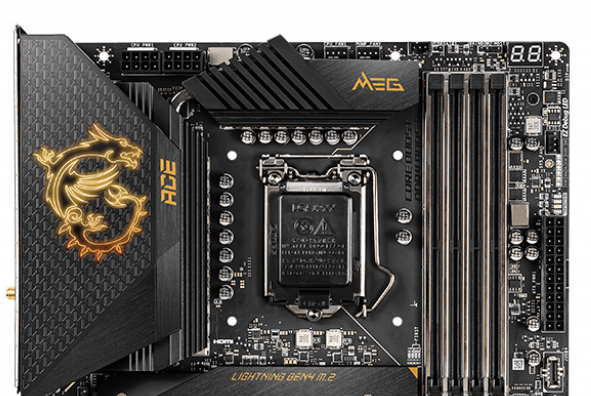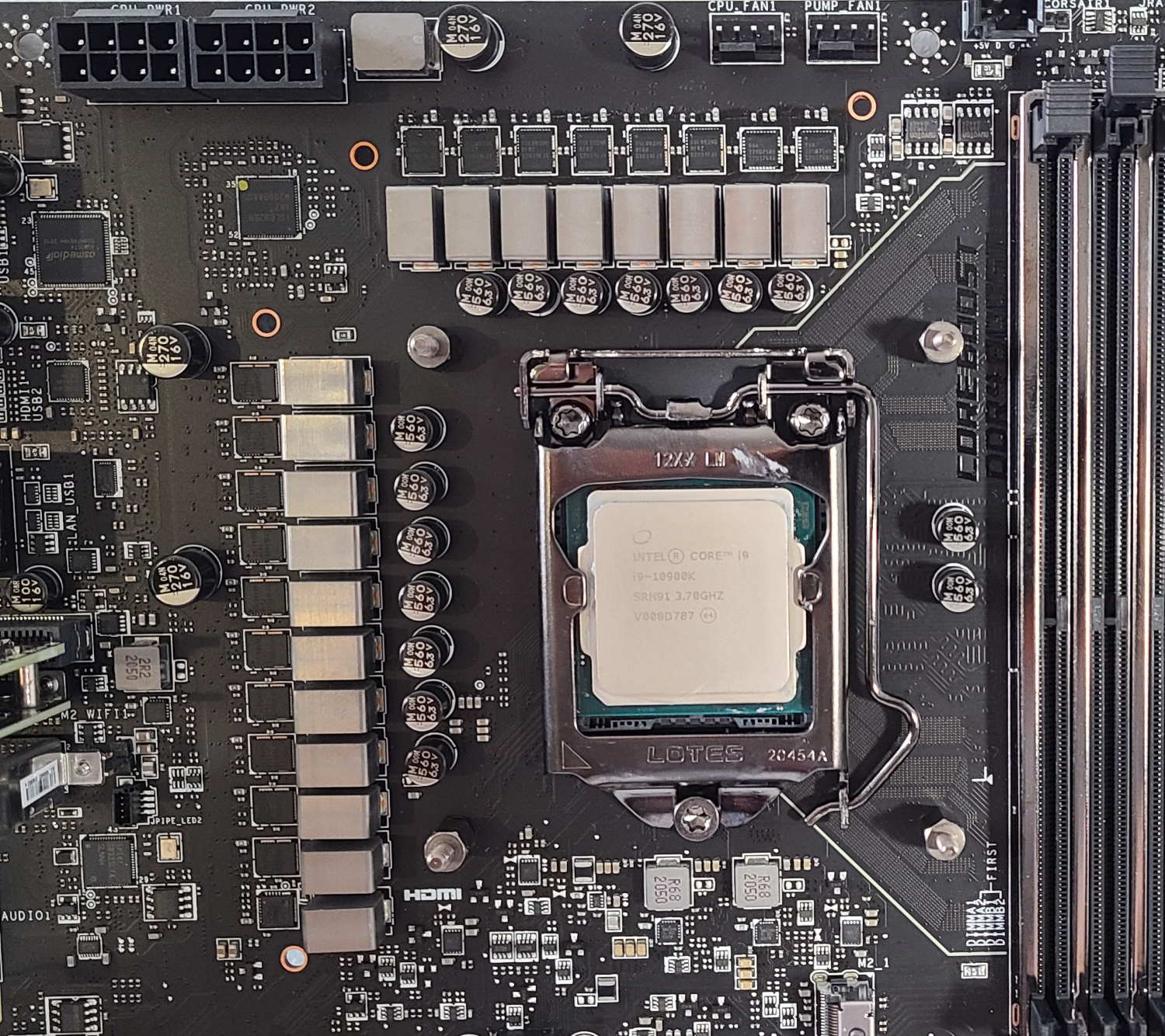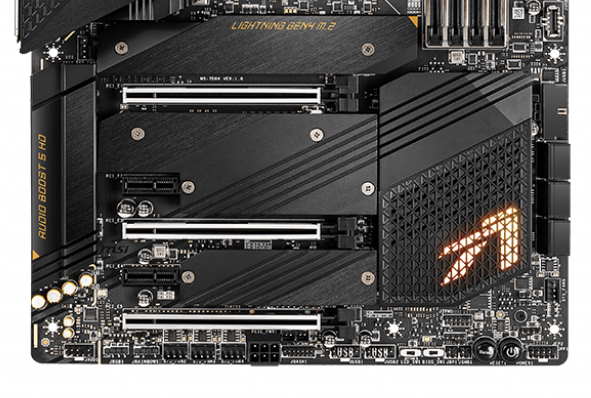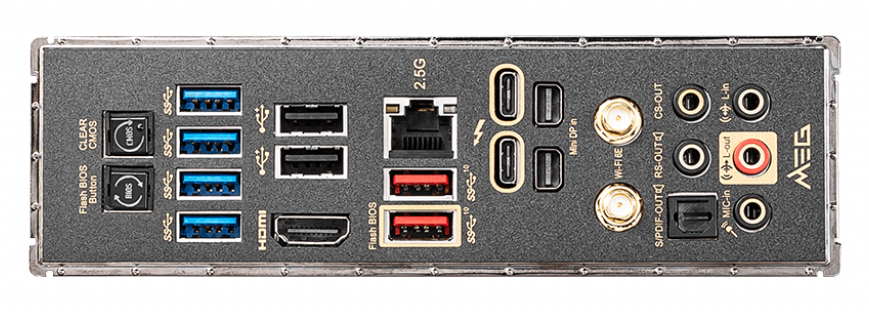Tom's Hardware Verdict
Priced at $499, the MEG Z590 Ace is a premium option for Intel’s new platform. But with four M.2 sockets, Wi-Fi 6E, robust power delivery, plus premium audio and styling, it delivers on the feature front. Just be aware when running AVX-512 loads with the power limits unlocked temperatures skyrocket.
Pros
- +
+ Robust 16-phase 90A VRM
- +
+ Four M.2 sockets
- +
+ Premium Audio Solution
- +
+ 2.5 GbE / Wi-Fi 6E
Cons
- -
Premium price
- -
Can’t run AVX-512 at stock
Why you can trust Tom's Hardware
Editor’s Note: A version of this article appeared as a preview, before we had a Rocket Lake CPU to test with Z590 motherboards. Now that we do (and Intel’s performance embargo has passed), we have completed testing (presented on page 3) with a Core i9-11900K and have added a score and other elements, as well as removing some now-redundant sentences and paragraphs, to make this a full review.
The latest version of the Ace board features robust power delivery, four M.2 sockets, a premium audio codec and more. The new Ace also has updated styling on the heatsink and shrouds while still keeping the black with gold highlights theme from the previous generation. Emblazoned on the rear IO is the MSI Dragon (with RGB LEDs) and the Ace name (no lighting). Pricing on the board comes in at a hefty $499, a significant markup over the previous generation. MSI states that includes the 25% tariffs and the reason for the increase.
MSI’s current Z590 product stack consists of 11 models, with most falling into the MEG (high-end) MPG (mid-range) and MAG (budget) lineups. We’re greeted by several familiar SKUs and a couple of new ones. Starting at the top is the flagship MEG Z590 Godlike, the Ace we’re looking at now, and a Mini ITX MEG Z590I Unify. The mid-range MPG line consists of four boards (Carbon EK X, Gaming Edge WiFi, Gaming Carbon WiFi and Gaming Force), while the less expensive MAG lineup consists of two boards (Z590 Tomahawk WiFi, and Torpedo). Wrapping up the current product stack are two ‘Pro’ boards in the Z590 Pro WiFi and Z590-A Pro. The only thing missing out of the gate is a Micro ATX board, but it’s likely we see one or two down the line.
On the performance front, we’re finally allowed to share information on these Z590 based motherboards using the Rocket Lake-based i9-11900K. In our tests, we saw the 8c/16t CPU hold its own against the previous generation 10c/20t CPU, especially in single-threaded tests. On the multi-core front, the IPC increase just isn’t enough to overcome the core/thread difference due to the IPC performance uptick. During our testing, the MSI MEG Z590 Ace performed well, showing solid results in our timed tests, PCMark 10 suite, and more. With the latest BIOS, the slight memory latency increase we observed (on this and other boards) was all but eliminated.
The problem with this board, and any board with power limits removed/raised significantly, is using AVX-512 instructions and stress testing. When using the ‘water cooling’ option in the BIOS (that removes all power limits) and running AIDA64, the temperature peaks at 100C in a matter of seconds, rendering it unusable. Other boards follow more closely to the Intel specification and throttle the AVX-512 clock speeds back to something more reasonable, while the Ace tries to run it at 4.8 GHz. In order to run AVX-512 on this board and complete some stress tests to verify stability, we had to run it with limits in place, setting Boxed cooler or Tower Air Cooler, or a significant offset.
To that end, we were able to push the new Rocket Lake CPU up to 5.1 GHz with all cores and threads enabled while keeping temperatures around 90 degrees Celsius. The overclocking process on the MEG Ace was painless as we simply set the voltage, multiplier and enabled LLC.
MSI’s MEG Z590 Ace includes all the bits you expect from a premium motherboard. The board has a stylish appearance, very capable power delivery (16-phase 90A Vcore) and the flagship Realtek ALC4082 audio codec with included DAC. We’ll cover these features and much more in detail below. First, here are the full specs from MSI.
MSI MEG Z590 Ace Specifications
| Socket | LGA 1200 |
| Chipset | Z590 |
| Form Factor | ATX |
| Voltage Regulator | 16+2+1 Phase (90A MOSFETs for Vcore) |
| Video Ports | (1) HDMI (v1.4) |
| (2) Mini-DisplayPort (input), (2) Thunderbolt 4 (output) | |
| USB Ports | (2) USB 3.2 Gen 2, Type-C (10 Gbps) |
| (4) USB 3.2 Gen 1, Type-C (5 Gbps) | |
| (2) USB 2.0, Type-A | |
| (2) Thunderbolt 4 (USB Type-C) ports (Up to 40 Gbps) | |
| Network Jacks | (1) 2.5 GbE |
| Audio Jacks | (5) Analog Plus SPDIF |
| Legacy Ports/Jacks | ✗ |
| Other Ports/Jack | ✗ |
| PCIe x16 | (2) v4.0 x16 |
| (1) v3.0 x16 | |
| (x16/x0/x4, x8/x8/x4, x8/x4+x4/x4) | |
| PCIe x8 | ✗ |
| PCIe x4 | ✗ |
| PCIe x1 | (2) PCIe 3.0 x1 |
| CrossFire/SLI | AMD Quad GPU Crossfire and 2-Way Crossfire, 2-Way Nvidia SLI |
| DIMM slots | (4) DDR4 5600+, 128GB Capacity |
| M.2 slots | (1) PCIe 4.0 x4 / PCIe (up to 110mm) |
| (2) PCIe 3.0 x4 / PCIe + SATA (up to 80mm) | |
| (1) PCe 3.0 x4 / PCIe (up to 80mm) | |
| U.2 Ports | ✗ |
| SATA Ports | (6) SATA3 6 Gbps (RAID 0, 1 and 10) |
| USB Headers | (1) USB v3.2 Gen 2 (Front Panel Type-C) |
| (1) USB v3.2 Gen 1 | |
| (2) USB v2.0 | |
| Fan/Pump Headers | (8) 4-Pin |
| RGB Headers | (2) aRGB (3-pin) |
| (2) RGB (4-pin) | |
| Legacy Interfaces | ✗ |
| Other Interfaces | FP-Audio, TPM |
| Diagnostics Panel | Yes, 4-LED 'Status LED' display, 2-character debug |
| Internal Button/Switch | LED/BIOS switches, Power/Reset buttons |
| SATA Controllers | ✗ |
| Ethernet Controller(s) | (1) Intel I225-V (2.5 GbE) |
| Wi-Fi / Bluetooth | (1) Intel Wi-Fi 6E AX210 (MU-MIMO, 2.4/5/6GHz, BT 5.2) |
| USB Controllers | ?? |
| HD Audio Codec | Realtek ALC4082 |
| DDL/DTS Connect | ✗ / DTS:X Ultra |
| Warranty | 3 Years |
The accessories included with the board are reasonably comprehensive, including most of what you need to get started. Below is a full list.
Get Tom's Hardware's best news and in-depth reviews, straight to your inbox.
- Manual
- Quick Installation Guide
- USB drive (Drivers)
- Cleaning brush
- Screwdrivers
- Stickers (MEG/Cable)
- (4) SATA cables
- (4) Screws/standoff sets for M.2 sockets
- Thermistor cable
- 1 to 2 RGB LED Y cable, Corsair RGB LED cable, Rainbow RGB LED cable
- DP to mini DP cable
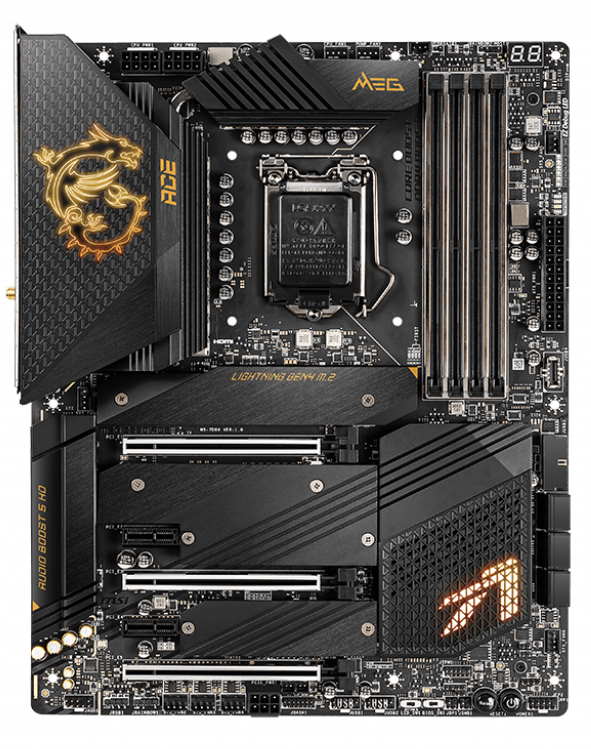

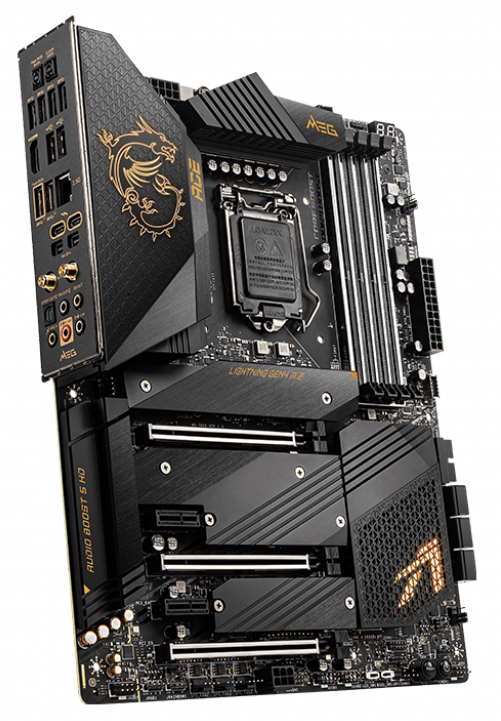
Looking at the Z590 Ace for the first time, we see the black PCB along with black heatsinks and shrouds covering most of the board. MSI stenciled on identifying language such as the MEG Ace name and the MSI Gaming Dragon in gold, setting this SKU apart from the rest. The VRM heatsinks are both made from a solid block of aluminum with lines cut out. Additionally, the shroud is made of metal and connected to the heat pipes, increasing surface area significantly. Also worth noting is the VRM heatsinks share the load connected via heatpipe. RGB LED lighting is minimal here, with a symbol on the chipset shining through a mesh cover on the chipset heatsink and the MSI dragon above the rear IO. While tastefully done, some may want more. With its mostly black appearance, the board won’t have trouble fitting in most build themes.
Focusing on the top half of the board, we’ll get a better look at what’s going with the VRM heatsinks and other board features in this area. In the upper-left corner, we spot two 8-pin EPS connectors, one of which is required for operation. Just below this is the shroud covering the rear IO bits and part of the VRM heatsink. On it is a carbon-fiber pattern along with the MSI Gaming Dragon illuminated by RGB LEDs. The socket area is relatively clean, with only a few caps visible.
Just above the VRM heatsink is the first of eight fan headers. All fan headers on the board are the 4-pin type and support PWM- and DC-controlled fans and pumps. The CPU_FAN1 header supports up to 2A/24W and auto-detects the attached device type. The PUMP_FAN1 supports up to 3A/36W. The rest of the system fan headers support up to 1A/12W. This configuration offers plenty of support for most cooling systems. That said, I would like to have seen all pump headers auto-detect PWM/DC modes instead of only CPU_FAN1.
To the right of the socket are four reinforced DRAM slots. The Z590 Ace supports up to 128GB of RAM with speeds listed up to DDR4 5600 (for one stick with one rank). The highest supported speed with two DIMMs is DDR4 4400+, which is plenty fast enough for an overwhelming majority of users.
Moving down the right edge of the board, we see the 2-character debug LED up top, a system fan header, five voltage read points (Vcore/DRAM/SA/IO/IO2), 4-LED debug, 24-pin ATX connector, and finally, a USB 3.2 Gen2 Type-C front panel header. Between both debug tools and the voltage read points, you’ll have an accurate idea of what’s going on with your PC.
With the MEG Z590 Ace towards the top of the product stack, you’d expect well-built power delivery and you wouldn’t be wrong. MSI lists the board as 16+2+1 (Vcore/GT/SA) and it uses a Renesas ISL69269 (X+Y+Z = 8+2+1) PWM controller that feeds power to eight-phase doublers (Renesas ISL617A), then onto 16 90A Renesas ISL99390B MOSFETs for the Vcore. This configuration yields 1440A of power for the CPU, which is plenty for ambient and sub-ambient/extreme overclocking. It won’t be this board holding you back in any overclocking adventures, that’s for sure.
As we focus on the bottom half, we’ll take a closer look at the integrated audio, PCIe slot configuration and storage. Starting with the audio bits on the left side, under the shroud, is the Realtek latest premium codec, the ALC4082. Additionally, the Z590 Ace includes an ESS Sabre 9018Q2C combo DAC, a dedicated headphone amplifier (up to 600 Ohm) and high-quality Chemicon audio capacitors. This audio solution should be more than adequate for most users.
In the middle of the board are four M.2 sockets and five PCIe slots. With the PCIe connectivity, all three full-length slots are reinforced to prevent shearing and EMI, while the two PCIe x1 slots don’t have any reinforcement. The top slot supports PCIe 4.0 x16 speeds, with the second and third slots PCIe 3.0. The slots break down as follows, x16/x0/x4 x8/x8/x4 or x8/x4+x4/x4. This configuration supports 2-Way Nvidia SLI and 2-Way AMD Crossfire technologies. All x1 slots and the full-length bottom slot are fed from the chipset, while the top two full-length slots source their lanes from the CPU.
M.2 storage on the Z590 Ace consists of four onboard sockets supporting various speeds and module lengths. The top slot, M2_1, supports PCIe 4.0 x4 modules up to 110mm. Worth noting on this socket is that it only works with an 11th Gen Intel CPU installed. M2_2, M2_3, M2_4 are fed from the chipset, with M2_2 and M2_3 supporting SATA- and PCIe-based modules up to 80mm, while M2_4 supports PCIe only. M2_2/3/4 are all PCIe 3.0 x4.
The way this is wired, you will lose some SATA ports and PCIe bandwidth depending on the configuration. For example, SATA2 is unavailable when using a SATA-based SSD in the M2_2 socket. SATA 5/6 are unavailable when using the M2_3 socket with any type of device. Finally, the bandwidth on M2_4 switches from x4 to x2 when PCI_E5 (bottom x1 slot) is used. The M.2 sockets support RAID 0/1 for those who would like additional speed or redundancy.
Finally, along the right edge of the board are six horizontally oriented SATA ports. The Z590 Ace supports RAID 0, 1 and 10 on the SATA ports. Just be aware you lose a couple of ports on this board if you’re using some of the M.2 sockets. Above these ports is a USB 3.2 Gen1 front panel header along with another 4-pin system fan header.
Across the board’s bottom edge are several headers, including more USB ports, fan headers, and more. Below is the full list, from left to right:
- Front Panel Audio
- aRGB and RGB headers
- (3) System Fan headers
- Supplemental PCIe power
- Tuning controller connector
- Temperature sensor
- (2) USB 2.0 headers
- LED switch
- BIOS selector switch
- OC Retry jumper
- TPM header
- Power and Reset buttons
- Slow mode jumpers
- Front panel connectors
Moving to the rear IO area, we see the integrated IO plate sporting a black background with gold writing matching the board theme. There are eight USB Type-A ports (two USB 3.2 Gen2, four USB 3.2 Gen1 and two USB 2.0 ports). On the Type-C front, the Z590 Ace includes two Thunderbolt 4 ports capable of speeds up to 40 Gbps. Just to the right of those are Mini-DisplayPort inputs for running video through the Thunderbolt connection(s). Handling the video output for the CPU’s integrated graphics is a single HDMI (2.0b) port. We also spy here the Wi-Fi antenna connections, 5-plug plus SPDIF audio stack, Intel 2.5 GbE and finally, a Clear CMOS button and BIOS Flashback button that can be used without a CPU.
MORE: Best Motherboards
MORE: How To Choose A Motherboard
MORE: All Motherboard Content

Joe Shields is a staff writer at Tom’s Hardware. He reviews motherboards and PC components.

